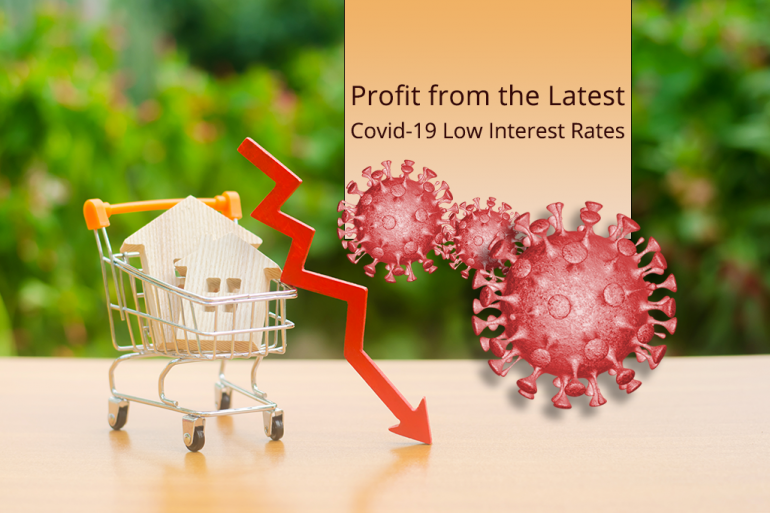Profit from the Latest Covid-19 Low Interest Rates
If you’re reading this, you’re probably in real estate. And if you’re in real estate, you’re probably aware that the world is experiencing two situations right now:
- A global pandemic
- A historically low interest rate environment
While we are reliant on top-tier medical professionals to help solve the first situation, the second situation is one we, real estate investors, should take advantage of.
Historically low interest rates equate to one thing for real estate investors: historically low mortgage rates.
Whether you own multiple investment properties or have not had the chance to buy your first one, this interest rate environment is not something you want to miss out on.
Here are ways we can profit from the current interest rate environment.#1: Buy More Real Estate
I believe that leverage is one of the most powerful tools that real estate investors — and all consumers — have at their disposal.
When you leverage something, you put some of your own money down and borrow the remaining purchase price. This loan (i.e., a mortgage) is typically given over 15 or 30 years and has a fixed interest rate that you pay back the loan on.
In 2018, those interests averaged 4%. In December 2020, the average 30-year interest rate was in the high 2s!
Financially, this means one thing: you can afford more bang for your buck.
Let’s say you were looking to buy a home in the pre-COVID-19 interest rate environment. Rates for a non-owner occupied property in 2019 moved around 4.5%.
When figuring out how much mortgage you can afford, the interest is critical. In 2019, a 30-year mortgage payment on a $150,000 loan at 4.5% would be $760 (not including escrows).
In 2020, the average interest rate just hit 2.65% on a 30-year, owner-occupied mortgage. Let’s use 3% to err on the conservative side for a non-owner occupied loan. A 30-year mortgage payment on a $150,000 loan at 3% would be $632. That’s a difference of $128/month, $1,536/year, and a whopping $46,080 over the life of the loan.
What if your mortgage was $300,000? Using the same rates, your 2019 payment at 4.5% would be $1,520 and your 2020 payment at 3% would be $1,265. That’s a difference of $255/month, $3,060/year, and $91,800 over the life of the loan!
With lower interest rates, real estate investors can afford a property that is higher in value compared with higher interest rate environments.
Any type of purchase money financing that you do in today’s low interest rate environment will be a good decision. Now, that is not to say go out and buy anything that has a chimney, but if you can find a deal that works, financing it with today’s interest rates will only make it sweeter.
#2: Refinance Your Current Portfolio
Refinances can seem complex but, like most mortgages, they are really just a financial tool to help you get what you want.There are two types of refinances.
Rate and Term Refinance
A rate and term refinance is where you simply change the rate on your mortgage and the term of the payment. Maybe you purchased a home in 2017 with a 30-year mortgage and got a bit of a higher rate at the time because the home is non-owner occupied — let’s say 5%.
Today, the rate is still 4.75% and you have 27 years left on your mortgage.
If you don’t have enough equity in the property, a rate and term refinance today for a non-owner occupied home may have an interest rate closer to 3.5%.
Take the investor who has 10 doors and a $100,000 mortgage on each property.
If this investor refinances all of his mortgages from 5% to 3.5%, each door will not only save $88 in monthly payment for a total of $880 in increased cash flow on a monthly basis, but they will also reduce the amount of interest they pay on the life of the loan by almost $50,000!
Reducing expenses and increasing your income is what it’s all about, and both can be achieved by extending the term back to 30 years and reducing your interest rate.
Cash-Out Refinance
The other kind of refinance is a cash-out refinance. To take advantage of a cash-out refinance, you need equity in your home — typically, more than 30% equity to really utilize a cash-out refinance mortgage.
Let’s says your home is worth $100,000. You have a mortgage of $50,000 at 4.75% interest. Here, you could do a cash-out refinance by getting a new mortgage for $75,000.
The new mortgage will pay off your old $50,000 mortgage, and you will be left with $25,000 cash. That money could be used to fix and flip or buy, rehab, rent, refinance, and repeat (BRRRR) another property.
Take Advantage of Low Interest Rates Before It’s Too Late!
Interest rates have gotten so low that, despite increasing your mortgage from $50,000 to $75,000 as outlined above, you may actually net a lower monthly payment (!), thus increasing the cash flow on your property. All the while you’re putting more cash in your bank account so you can purchase your next property.
That is how you profit in a historically low interest rate environment.








